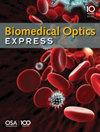基于全介质结构中高 Q 因子多法诺共振的多功能传感应用
IF 2.9
2区 医学
Q2 BIOCHEMICAL RESEARCH METHODS
引用次数: 0
摘要
本文设计并分析了一种基于全介质结构的多功能传感器,可同时进行温度和折射率传感。该结构由置于二氧化硅基底上的硅二聚体周期性阵列组成。通过打破结构的对称性,可将连续体中的理想束缚态转换为连续体中的准束缚态,并在近红外波段激发出三个法诺共振。结合电磁场分布,分析出三个法诺共振的共振模式分别为磁偶极子、磁环偶极子和电环偶极子。所提出的传感器显示出令人印象深刻的 9352 最大 Q 因子,调制深度接近 100%。我们对温度和折射率传感特性的研究表明,其最大温度灵敏度为 60 pm/K。在折射率传感方面,灵敏度和优点系数分别为 279.5 nm/RIU 和 2055.1 RIU-1。这些发现强调了全介质元结构在同时进行多参数测量方面的潜力。该传感器的多功能性表明其在生物和化学传感领域的应用前景广阔。本文章由计算机程序翻译,如有差异,请以英文原文为准。
Multi-function sensing applications based on high Q-factor multi-Fano resonances in an all-dielectric metastructure
A multi-function sensor based on an all-dielectric metastructure for temperature and refractive index sensing simultaneously is designed and analyzed in this paper. The structure is composed of a periodic array of silicon dimers placed on the silicon dioxide substrate. By breaking the symmetry of the structure, the ideal bound states in the continuum can be converted to the quasi-bound states in the continuum, and three Fano resonances are excited in the near-infrared wavelength. Combining with the electromagnetic field distributions, the resonant modes of three Fano resonances are analyzed as magnetic dipole, magnetic toroidal dipole, and electric toroidal dipole, respectively. The proposed sensor exhibits an impressive maximal Q-factor of 9352, with a modulation depth approaching 100%. Our investigation into temperature and refractive index sensing properties reveals a maximum temperature sensitivity of 60 pm/K. Regarding refractive index sensing, the sensitivity and figure of merit are determined to be 279.5 nm/RIU and 2055.1 RIU-1, respectively. These findings underscore the potential of the all-dielectric metastructure for simultaneous multi-parameter measurements. The sensor's versatility suggests promising applications in biological and chemical sensing.
求助全文
通过发布文献求助,成功后即可免费获取论文全文。
去求助
来源期刊

Biomedical optics express
BIOCHEMICAL RESEARCH METHODS-OPTICS
CiteScore
6.80
自引率
11.80%
发文量
633
审稿时长
1 months
期刊介绍:
The journal''s scope encompasses fundamental research, technology development, biomedical studies and clinical applications. BOEx focuses on the leading edge topics in the field, including:
Tissue optics and spectroscopy
Novel microscopies
Optical coherence tomography
Diffuse and fluorescence tomography
Photoacoustic and multimodal imaging
Molecular imaging and therapies
Nanophotonic biosensing
Optical biophysics/photobiology
Microfluidic optical devices
Vision research.
 求助内容:
求助内容: 应助结果提醒方式:
应助结果提醒方式:


